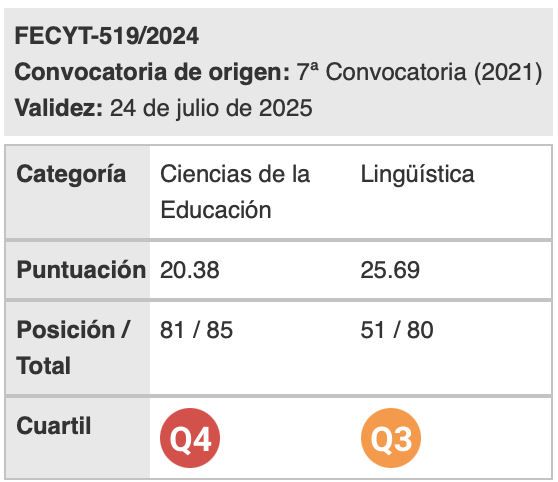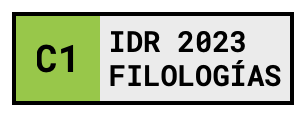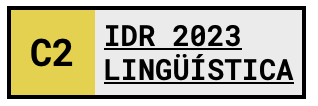Foreign language learning needs in higher education: Reasons for convergence and accountability
Palabras clave:
needs analysis, teaching English as a foreign language, European Space for Higher Education, Common European Framework, quality assurance, accountabilityResumen
Needs analysis is a relevant issue in language teaching as its final aim is to enhance the language learning process by setting realistic course objectives. This paper briefly reviews past and present approaches to the concept of “needs” and “needs analysis” in foreign language (FL) methodology with particular reference to the higher education context and the post-Bologna reform. It discusses the complex interplay of addressing target and learning FL needs by gathering data from different stakeholder groups and making use of different data collection instruments. Then, it explores current trends in needs analysis research and explains how “competences” and “profiling” have surpassed “needs” and “needs analysis” in the educational systems under the European Space of Higher Education. Last, this study addresses the implications of adopting a more critical, quality-driven approach to FL needs analysis with a view to attaining a more participatory and accountable higher education.
DOI: 10.20420/rlfe.2015.0001
Descargas
Citas
Alalou, A. (2001). Reevaluating curricular objectives using students’ perceived needs: The case of three language programs. Foreign Language Annals, 34(5), 453-469.
Amaral, A. (2007). Higher education and quality assessment. The many rationales for quality. In L. Bollaert et al. (Eds.), Embedding Quality Culture in Higher Education, EUA case Studies 2007 (pp. 6-10). <http://www.eua.be/Libraries/EQAF_2010/EUA_QA_Forum_ publication _1.sflb.ashx>
Atai, M. R., & Nazari, O. (2011). Exploring reading comprehension needs of Iranian EAP students of health information management (HIM): A triangulated approach. System, 39(1), 30-43.
Bacha, N. N., & Bahous, R. (2008). Contrasting views of business students’ writing needs in an EFL environment. English for Specific Purposes, 27(1), 74-93.
Bardi, M., & Muresan, L. (2012). Student perceptions of programme quality – A tool for improvement. Quality Review for Higher Education, 4(1), 14-22.
Basturkmen, H. (1998). Refining procedures. A needs analysis project at Kuwait University. English Teaching Forum, 36(4), 2-18.
Basturkmen, H. (2006). Ideas and Options in English for Specific Purposes. Mahwah, NJ: Lawrence Erlbaum.
Basturkmen, H. (2010). Developing Courses in English for Specific Purposes. New York: Palgrave Macmillan.
Basturkmen, H. (2013). Needs analysis and syllabus design for Language for Specific Purposes. In C. A. Chapelle (Ed.), The Encyclopedia of Applied Linguistics (pp. 4209-4217). Oxford: Blackwell.
Belcher, D. (2009). What ESP is and can be: An introduction. In D. Belcher (Ed.), English for Specific Purposes in Theory and Practice (pp. 1-20). Ann Arbor, MI: University of Michigan Press.
Benesch, S. (2001). Critical English for Academic Purposes: Theory, Politics, and Practice. Mahwah, NJ: Lawrence Erlbaum.
Bocanegra-Valle, A. (in press). Needs analysis for curriculum design. In K. Hyland & P. Shaw (Eds.). Handbook of English for Academic Purposes. Abingdon, Oxford: Routledge.
Bollaert, L. et al. (Eds.) (2007), Embedding Quality Culture in Higher Education, EUA case Studies 2007. <http://www.eua.be/Libraries/EQAF_2010/EUA_QA_Forum_publication_1.sflb.ashx>
Borza, A., & Crişan, C. (2012). Employers’ expectations: Competencies of entrepreneurs versus competencies of graduates of higher education. Quality Review for Higher Education, 4(2), 29-40.
Breeze, R. (2014). Identifying needs in English-medium university courses. In R. Breeze, C. Llamas Saiz, C. Martínez Pasamar & C. Tabernero Sala (Eds.), Integration of Theory and Practice in CLIL (pp. 143-159). Amsterdam/New York: Rodopi.
Brown, J. D. (2009). Foreign and second language needs analysis. In M. H. Long & C. J. Doughty (Eds.), The Handbook of Language Teaching (pp. 269-293). West-Sussex: Wiley-Blackwell.
Cerkez, M. (2010). Defining quality in higher education – Practical implications. Quality Review for Higher Education, 2(2), 109-119.
Chan, V. (2001). Determining students’ language needs in a tertiary setting. English Teaching Forum, 39(3), 16-27.
Chaudron, C., C. J. Doughty, Y. Kim, D. -K. Kong, J. Lee, Y.-G. Lee, M. H. Long, R. Rivers & K. Urano (2005). A task-based needs analysis of a tertiary Korean as a foreign language program. In M. H. Long (Ed.), Second Language Needs Analysis (pp. 225-261). New York, NY: Cambridge University Press.
Chowdhury, T.A., & Haider, Md.Z. (2012). A need-based evaluation of the EAP courses for the pharmacy students in the University of Asia Pacific (UAP), Bangladesh. Asian Social Science, 8(15), 93-107.
Coste, D. (2007). Contextualising Uses of the Common European Framework of Reference for Languages. Council of Europe Language Policy Division. <http://www.coe.int/t/dg4/ linguistic/Publications_EN.asp - P115_3863>
Council of Europe (2001). Common European Framework of Reference for Languages: Learning, Teaching, Assessment. Language Policy Unit. <http://www.coe.int/t/dg4/linguistic/source/ framework_en.pdf> [02/09/2014]
EAQUALS (2011). Inspection Scheme version 6.2 – Reference Guide for Institutions.
EAQUALS (2013). The EAQUALS Framework for Language Teacher Training and Development. <http://clients.squareeye.net/uploads/eaquals/EAQUALS_TD_FRAM__November_2013. pdf>
Eslami, Z. R. (2010). Teachers’ voice vs. students’ voice: A needs analysis approach to English for Academic Purposes (EAP) in Iran. English Language Teaching, 3(1), 3-11.
Evans, S., & Green, C. (2007). Why EAP is necessary: A survey of Hong Kong tertiary students. Journal of English for Academic Purposes, 6(1), 3-17.
Ferris, D. (1998). Students’ views of academic aural/oral skills: a comparative needs analysis. TESOL Quarterly, 32(2), 289-319.
Flowerdew, L. (2013). Needs analysis and curriculum development. In B. Paltridge & S. Starfield (Eds.), The Handbook of English for Specific Purposes (pp. 325-346). West-Sussex: Wiley-Blackwell.
Hall, D. R. (2013). Introduction. In M. Huhta, K. Vogt, E. Johnson & H. Tulkki. Needs Analysis for Language Course Design. A Holistic Approach to ESP (pp. 1-8). Cambridge: Cambridge University Press.
Harvey, L. (2007). Quality culture, quality assurance and impact. Overview of discussions. In L. Bollaert et al. (Eds.), Embedding Quality Culture in Higher Education, EUA case Studies 2007 (pp. 81-84), <http://www.eua.be/Libraries/EQAF_2010/EUA_QA_Forum_publication_1.sflb. ashx> [02/09/2014]
Heyworth, F. (2007). Quality and people. In L. Muresan, F. Heyworth, G. Mateva & M. Rose (Eds.), QualiTraining - A Training Guide for Quality Assurance in Language Education (pp. 7-21). Strasbourg: Council of Europe.
Heyworth, F. (2013). Applications of quality management in language education. Language Teaching, 46(3), 281-315.
Huhta, M., Vogt, K., Johnson, E., & Tulkki, H. (2013). Needs Analysis for Language Course Design. A Holistic Approach to ESP. Cambridge: Cambridge University Press.
Hutchinson, T., & Waters, A. (1987). English for Specific Purposes. A Learning-centred Approach. Cambridge: Cambridge University Press.
Hyland, K. (1997). Is EAP necessary? A survey of Hong Kong undergraduates. Asian Journal of English Language Teaching, 7, 77-99.
Hyland, K. (2006). English for Academic Purposes. An Advanced Resource Book. Oxon: Routledge.
Johns, A. (2009). Tertiary undergraduate EAP: Problems and possibilities. In D. Belcher (Ed.), English for Specific Purposes in Theory and Practice (pp. 41-59). Ann Arbor, MI: University of Michigan Press.
Karimkhanlouei, G. (2012). What do medical students need to learn in their English classes? Journal of Language Teaching and Research, 3(3), 571-577.
Kormos, J., Kontra, E. H., & Csölle, A. (2002). Language wants of English majors in a non-native context. System, 30(4), 517-542.
Lambert, C. (2010). A task-based needs analysis: Putting principles into practice. Language Teaching Research, 14(1), 99-112.
Liu, J-Y, Chang, Y-J., Yang, F-Y., & Sun, Y-C. (2011). Is what I need what I want? Reconceptualising college students’ needs in English courses for general and specific/academic purposes. Journal of English for Academic Purposes, 10(4), 271-280.
Long, M. H., & Crookes, G. (1993). Units of analysis in syllabus design: The case for task. In G. Crookes & S. Gass (Eds.), Tasks in a Pedagogical Context (pp. 9-54). Clevedon, Avon: Multilingual Matters.
Long, M. H. (2000). Focus on form in task-based language teaching. In R. Lambert & E. Shohamy (Eds.), Language Policy and Pedagogy: Essays in Honor of Ronald Walton (pp. 181-196). Amsterdam: John Benjamins.
Long, M. H. (2005). Methodological issues in learner needs analysis. In M. H. Long (Ed.), Second Language Needs Analysis (pp. 19-76). New York, NY: Cambridge University Press.
Long, M. H. (2013). Needs analysis. In C. A. Chapelle (Ed.), The Encyclopedia of Applied Linguistics (pp. 3569-3572). Oxford: Blackwell.
Munby, J. (1978). Communicative Syllabus Design. Cambridge: Cambridge University Press.
Muresan, L. (2011). The dynamics of shared values in language education and local endeavours in times of change. In C. Pérez-Llantada & M. Watson (Eds.), Specialised Languages in the Global Village. A Multi-Perspective Approach (pp. 47-76). Cambridge: Cambridge Scholars.
Muresan, L., & Ursa, O. (2014). Ingredients of a quality culture in language education – The way forward in LSP/EAP contexts. In S. Munteanu & E. Păcurar (Eds.), Studii de diversitate culturală şi limbaje de specialitate (pp. 127-139). Cluj-Napoca: Casa Cărţii de Ştiinţă.
Nunan, D. (1988). The Learner-Centred Curriculum. Cambridge: Cambridge University Press.
Richterich, R., & Chancerel, J.L. (1980). Identifying the Needs of Adults Learning a Foreign Language. Strasbourg: Council of Europe.
Robinson, P. (1991). ESP Today. London: Prentice Hall.
Taillefer, G. F. (2007). The professional language needs of Economics graduates: Assessment and perspectives in the French context. English for Specific Purposes, 26(2), 135-155.
Upton, T. A. (2012). LSP at 50: Looking back, looking forward. Ibérica, 23, 9-28.
Van Avermaet, P., & Gysen, S. (2009). From needs to tasks. Language learning needs in a task-based approach. In K. Van den Branden, M. Bygate & J. M. Norris (Eds.), Task-Based Language Teaching. A Reader (pp. 144-170). Amsterdam. John Benjamins.
Descargas
Publicado
Cómo citar
Número
Sección
Licencia
Aquellos autores/as que tengan publicaciones con esta revista, aceptan los términos siguientes:
- Los autores/as conservarán sus derechos de autor y garantizarán a la revista el derecho de primera publicación de su obra, el cuál estará simultáneamente sujeto a la Licencia de reconocimiento de Creative Commons que permite a terceros compartir la obra siempre que se indique su autor y su primera publicación esta revista.
- Los autores/as podrán adoptar otros acuerdos de licencia no exclusiva de distribución de la versión de la obra publicada (p. ej.: depositarla en un archivo telemático institucional o publicarla en un volumen monográfico) siempre que se indique la publicación inicial en esta revista.
- Se permite y recomienda a los autores/as difundir su obra a través de Internet (p. ej.: en archivos telemáticos institucionales o en su página web) antes y durante el proceso de envío, lo cual puede producir intercambios interesantes y aumentar las citas de la obra publicada. (Véase El efecto del acceso abierto).

Revista de Lenguas para fines específicos is licensed under a Creative Commons Reconocimiento-NoComercial-SinObraDerivada 4.0 Internacional License.






















